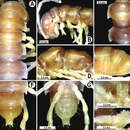Description
provided by Zookeys
Length 18–19 mm (♂), width of midbody pro- and metazonae 1.0–1.1 and 1.5–1.7 mm (♂), respectively (versus length 25 mm and width of midbody metazonae 1.6 mm, as given in the original description (Attems 1953)). Lectotype 18 mm long, 1.0 and 1.5 mm wide on midbody pro- and metazonae, respectively. Coloration of alcohol material after long preservation rather uniformly brown (Fig. 12A–G) (versus blackish brown with edges of paraterga and legs yellowish brown, as given in the description (Attems 1953)).
Clypeolabral region sparsely setose, vertex smooth, epicranial suture distinct. Antennae long and slender (Fig. 12B), extending behind body segment 5 (♂) dorsally. In width, head < segments 2–4 < collum < 5–17 (♂), gently and gradually tapering thereafter. Collum smooth, with three transverse rows of setae, 4+4 anterior, 2+2 intermediate, and 3+3 posterior; caudal corner of paraterga subrectangular, narrowly rounded (Fig. 12A). Tegument smooth and shining; metaterga and prozonae finely shagreened; surface below paraterga finely microgranulate. Postcollum with an anterior (pre-sulcus) transverse row of 2+2, mostly abraded setae; caudal (post-sulcus) row barely traceable as 3+3 insertion points. Tergal setae short, simple, slender, about 1/3 of metatergal length. Axial line barely visible, starting from collum. Paraterga very strongly developed (Fig. 12A, C, F, G), mostly subhorizontal and lying below dorsum, thin blunt blades in lateral view, a little thicker only on pore-bearing segments, posterior edge concave, caudal tip narrowly rounded. Calluses delimited by a sulcus only dorsally, rather narrow. Paraterga 2 broad, slightly upturned, anterior edge nearly straight, lateral edge with three more or less evident incisions; posterior edge clearly concave (Fig. 12A, B). Anterior edge of postcollum segments oblique, bordered and fused to callus, lateral edge with a strong incision near front 1/3; posterior edge oblique. Ozopores evident, lateral, lying inside an ovoid groove at about 1/4 metazonital length before caudal corner. Transverse sulcus complete on metaterga 5–18, shallow, not reaching bases of paraterga, faintly beaded at bottom (Fig. 12A, C, F). Stricture between pro- and metazonae broad, shallow, ribbed at bottom down to base of paraterga. Pleurosternal carinae complete crests only on segment 2, with a small sharp caudal tooth on segments 3–7, onward missing (Fig. 12B, D, E). Epiproct (Fig. 12E–G) conical, flattened dorsoventrally, apical papillae evident and large; tip subtruncate; pre-apical papillae small, but visible, lying close to tip. Hypoproct (Fig. 12G) roundly subtrapeziform, setiferous knobs at caudal margin small and well-separated.
Sterna sparsely setose, with a large central cone between coxae 3 and a small central lobe with a paramedian pair of evident, sparsely setose, apical cones between coxae 4 (♂) (Fig. 12H, I); segments 8–16 with a strong cone caudally near each coxa. Legs long and slender, midbody ones ca 1.4–1.5 (♂) as long as body height, legs on segments 8–18 with a small adenostyle on each prefemur, femur and postfemur (Fig. 13C); tarsal brushes absent.
Gonopods (Fig. 13A, B) very simple; coxa a little curved caudad, sparsely setose distoventrally. Prefemur densely setose, about 1/3 as long as femorite + “postfemoral” part. Femorite rather slender, expanded distad, slightly curved, showing a mesal groove; lobe l simple; solenophore long and slender, typically coiled, tip subtruncate; process h short, rather curved, tip acute.
- license
- cc-by-3.0
- copyright
- Natdanai Likhitrakarn, Sergei I. Golovatch, Somsak Panha
- bibliographic citation
- Likhitrakarn N, Golovatch S, Panha S (2014) Three new species of the millipede genus Tylopus Jeekel, 1968 from Thailand, with additional notes on the species described by Attems (Diplopoda, Polydesmida, Paradoxosomatidae) ZooKeys 435: 63–91
- author
- Natdanai Likhitrakarn
- author
- Sergei I. Golovatch
- author
- Somsak Panha

